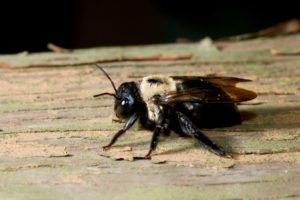CARPENTER BEES MAY OR MAY NOT BE A PROBLEM
By Zachary Ciras on April 30, 2021.
We are approaching the time of year when large black and yellow carpenter bees begin their nest building in wood, perhaps around your house or deck. The bee pair will be very busy and very visible for a short time. The female does the work chewing out a circular gallery opening, laying eggs, and provisioning each individual bee cell. Meanwhile, the male carpenter bee does a great job of guarding the nest site, buzzing and diving at all intruders (but guess what – he doesn’t have a stinger!)
HERE ARE THE REASONS WHY YOU SHOULDN’T BE TOO CONCERNED ABOUT CARPENTER BEE ACTIVITY
1. As aggressive as their activities seem to be, carpenter bees are temporary pests. The nest building and provisioning process is completed in only about a week in spring.
2. There is no growing hive of bees to attack you later. Carpenter bees are solitary bees, nest building as a single pair, although multiple pairs may be active in the same area. Carpenter bees are similar in appearance, though, to bumble bees that nest most often in the ground and are part of a large colony.
3. Stings are rare. Carpenter bees are fairly docile, but will protect the nest if threatened. The male bee that is the buzzing, intimidating guard cannot sting. He is all bluff. Only the female bee can sting but she is busy and not aggressive.
4. Like other bees, carpenter bees are beneficial pollinators. The female bee collects pollen which she shapes into food balls, placing one in each of 6-8 excavated cells to feed her developing larvae. Once each cell is provisioned with an egg and food, it’s sealed off. Grub-like bee larvae develop into winged bees over several weeks, usually emerging from the nest gallery in late summer.
5. Damage is mostly cosmetic and rarely structural. The bees prefer soft, weathered, aged, unpainted wood. That often means deck railings, deck furniture, fascia boards, eaves, fence posts, or other trim. The round entrance holes are usually on the back side of the wood piece and not even visible. But the hollowed gallery inside the wood can be several inches long and the diameter of a dime.
HERE ARE THE REASONS WHY YOU MIGHT BE CONCERNED ABOUT CARPENTER BEE ACTIVITY
1. In some sites, carpenter bee nest galleries can become unsightly, especially when nests appear in the same place year after year. When damaged wood has to be replaced, their presence becomes an issue. Damage is also more serious when multiple pairs of bees nest in the same site.
2. Fecal drips can stain siding. When the bees are working up high, entering a nest on the unpainted backside of a fascia board for example, they can leave yellow-brown liquid fecal stains that run from the nest opening down onto surfaces below. The presence of these drips alerts you to a carpenter bee gallery above.
3. Most carpenter bee damage issues are caused after the fact when woodpeckers attack the affected wood trying to reach juicy bee larvae inside. The birds can peck large holes into decks and other affected sites and don’t give up easily.
4. At-risk individuals can be a concern. Even though the female bee rarely stings, her presence could be an issue if there is a sting-allergic person, or small children or pets, that might interact with the bees during the brief nest building period.

Carpenter bee
There are various ways to limit the nesting activity of carpenter bees and the later efforts of hungry woodpeckers. Sometimes simply painting or sealing susceptible woods will discourage the bees, especially if activity is new. Give Colonial Pest a call if you are experiencing over-eager carpenter bees or if you have had bee nesting damage in the past.
If you don’t have issues with the brief nesting activities of carpenter bees, they’re great fun for kids to watch – from a safe distance. When the nests are completed and the bees have moved on, see if you can find the round entrance hole in the wood where the female entered to lay her eggs and to leave pollen behind for her offspring.
To learn all about carpenter bees and their nest building, see these Colonial blogs: